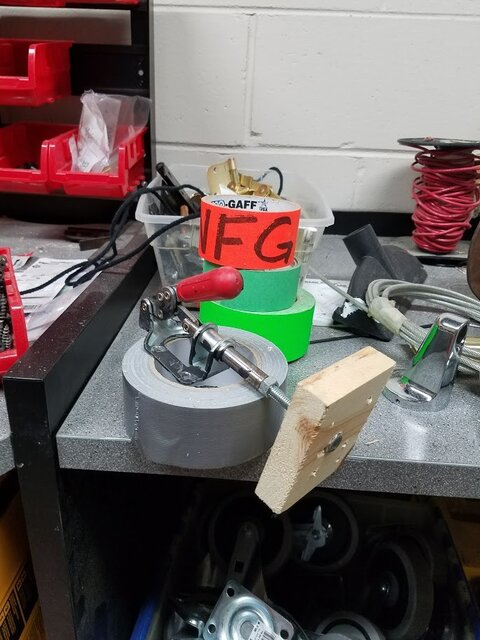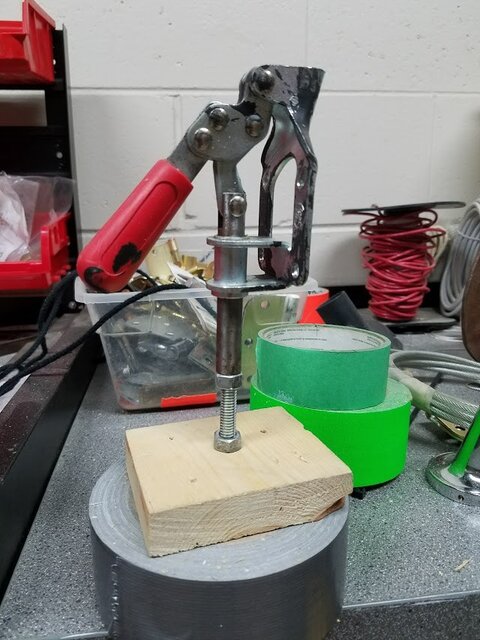Stoickthelesser
Member
Last edited by a moderator:
The casters already have a fair amount of height, so the brake is only really lifting the wagon about a half inch beyond that. The ones I have definitely don't keep a unit in place on their own.
I never really counted on Wagon Brakes to actually hold a wagon in place, if there was movement on it. If it had to be held in place with a dynamic lateral forces I always installed a cane bolt or stage screw and insert, or tracked it. That being said De-sta-co was always my go-to for brakes.
The casters already have a fair amount of height, so the brake is only really lifting the wagon about a half inch beyond that. The ones I have definitely don't keep a unit in place on their own.
I'll definitely check them out- another issue I've run into is that the only brakes I've found that aren't way too tall to be used on conventional wagons aren't rated for more than 150lb or so. Building all of my wagons out of 2x6 or 2x8 just isn't feasible- cost increase aside, my director would pitch an artist fit at the aesthetic change.
It sounds like I may be working from some bad starting assumptions. I was taught that the purpose of the wagon brake was to lift its associated caster just off the stage, keeping it from turning and transferring pressure to its opposite caster, in turn increasing that caster's resistance to turning. Was that inaccurate?
I was taught the same thing, and if you check out Rosebrand's products page, they agree. That being said, we bend at least 25% of the brakes we use. One trick I have found is replacing the rubber tipped bolt with something a little longer and beefier. That being said, it is obvious that they are not strong enough so I have always been looking for a better solution that doesn't involve drilling into the floor. So far, no such luck. I've been tempted to try out their floor locks, but Haven't had the opportunity as of yet. Would love to hear if anyone has experience with these.It sounds like I may be working from some bad starting assumptions. I was taught that the purpose of the wagon brake was to lift its associated caster just off the stage, keeping it from turning and transferring pressure to its opposite caster, in turn increasing that caster's resistance to turning. Was that inaccurate?
I was taught the same thing, and if you check out Rosebrand's products page, they agree. That being said, we bend at least 25% of the brakes we use. One trick I have found is replacing the rubber tipped bolt with something a little longer and beefier. That being said, it is obvious that they are not strong enough so I have always been looking for a better solution that doesn't involve drilling into the floor. So far, no such luck. I've been tempted to try out their floor locks, but Haven't had the opportunity as of yet. Would love to hear if anyone has experience with these.
I have use another brand of floor locks here in Australia. they are about $90 aud and will lift up and hold the wagon up off its casters. I usually use 2 and lift one side so the wagons don't move when mounting and dismounting by cast. They are also usually used on smaller wagons that go on and off stage. Any wagon that is on stage the whole time is screwed in place.I was taught the same thing, and if you check out Rosebrand's products page, they agree. That being said, we bend at least 25% of the brakes we use. One trick I have found is replacing the rubber tipped bolt with something a little longer and beefier. That being said, it is obvious that they are not strong enough so I have always been looking for a better solution that doesn't involve drilling into the floor. So far, no such luck. I've been tempted to try out their floor locks, but Haven't had the opportunity as of yet. Would love to hear if anyone has experience with these.
I have use another brand of floor locks here in Australia. they are about $90 aud and will lift up and hold the wagon up off its casters. I usually use 2 and lift one side so the wagons don't move when mounting and dismounting by cast. They are also usually used on smaller wagons that go on and off stage. Any wagon that is on stage the whole time is screwed in place.
Hope this helps https://www.rjcox.com.au/product/3288/37001/hammerlock-friction-pad-floor-locks-909100/
Regards
Crispy
Reminded me of what I did on a show last year, so I checked the shop. I was having a hard time with the brake hurting the floor, this solved that... Just attached another 1 x 4 to it to sandwich the bolt and we were good to go.I saw an interesting modification idea in one of the trade mags a while back. The user took two heavy duty breaks and bolted one to each end of a length of 2x4, countersinking the bolts to allow only the face of the board to touch the floor. They then welded a rod to the handles of the breaks to allow them to be set down at the same time. This gives you much bigger surface area for stability and strength. I tried to find a photo but couldn't..... and I don't have a chance to draw it out.... So I apologize if my description isn't clear...
I can't wait to give it a try myself though!


I saw an interesting modification idea in one of the trade mags a while back. The user took two heavy duty breaks and bolted one to each end of a length of 2x4, countersinking the bolts to allow only the face of the board to touch the floor. They then welded a rod to the handles of the breaks to allow them to be set down at the same time. This gives you much bigger surface area for stability and strength. I tried to find a photo but couldn't..... and I don't have a chance to draw it out.... So I apologize if my description isn't clear...
I can't wait to give it a try myself though!
We use essential cookies to make this site work, and optional cookies to enhance your experience.

